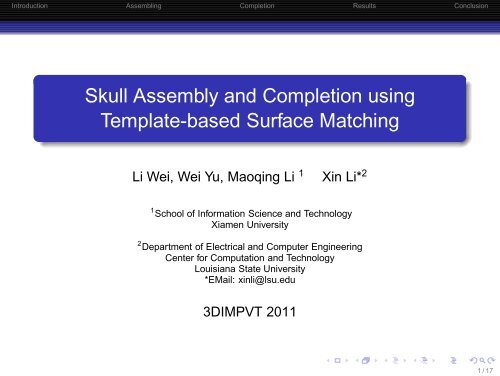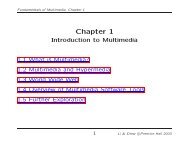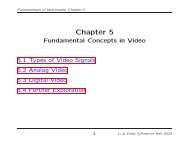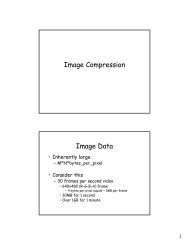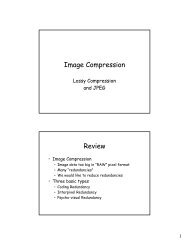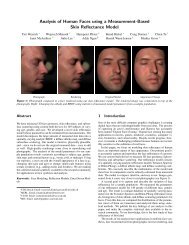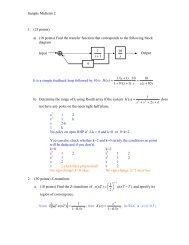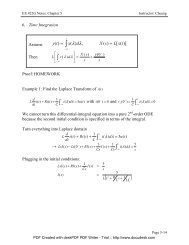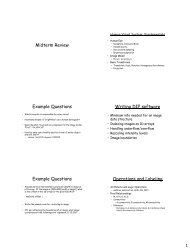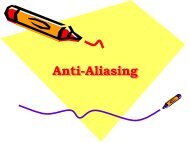Link to presentation
Link to presentation
Link to presentation
Create successful ePaper yourself
Turn your PDF publications into a flip-book with our unique Google optimized e-Paper software.
Introduction Assembling Completion Results ConclusionSkull Assembly and Completion usingTemplate-based Surface MatchingLi Wei, Wei Yu, Maoqing Li 1 Xin Li* 21 School of Information Science and TechnologyXiamen University2 Department of Electrical and Computer EngineeringCenter for Computation and TechnologyLouisiana State University*EMail: xinli@lsu.edu3DIMPVT 20111 / 17
Introduction Assembling Completion Results ConclusionIntroductionGoalTo assemble and repair fragmented skulls <strong>to</strong>complete models.MotivationSkull Completion is important in forensicand anthropological facial reconstruction.The traditional state-of-the-art approach:Time consumingDomain expertise requiredSubjective when large regions are missingProposed Approach:Computer-aided completion in digitalenvironment2 / 17
Introduction Assembling Completion Results ConclusionRelated Work3 / 17
Introduction Assembling Completion Results ConclusionAlgorithm Pipeline4 / 17
Introduction Assembling Completion Results ConclusionFragmented Skull AssemblingIn: A set of fragments M i and template S.Out: A set of rigid transformations T i (applied on M i ), so that thearrangement of all fragments in world coordinates wellapproximates S.5 / 17
Introduction Assembling Completion Results ConclusionFeature ExactionFeature ExtractionSlippage Feature on each Fragment M i .SignatureSpin Image [Johnson et al. 1999].Why Spin Image?Comparing the GeometricProperties of regions.Our Modified Spin-ImageSignatureResolution-InvarianceDirection Filtering6 / 17
Introduction Assembling Completion Results ConclusionFinding Coarse CorrespondenceI/OIn: Spin image signatures on fragments feature points andtemplate points.Out: Correspondence from feature points (on fragments) <strong>to</strong> thetemplate.The most possible many-<strong>to</strong>-manymapping (most similarcorresponding pairs of points) isthe coarse correspondence.7 / 17
Introduction Assembling Completion Results ConclusionFragment-Template MatchingOptimal CorrespondenceExact a most isometric sub-set[Tevs et al. 2009].Local RegistrationCompute rigid transform by optimal corresponding.8 / 17
Introduction Assembling Completion Results ConclusionInter-Fragment RefinementAvoid Intersection Between FragmentsRefinement:Taking the computed transformations as starting variables, <strong>to</strong>minimize the objective function composed of three terms:E(T 1 , . . . , T n) = αE I + βE F + γE T ,whereE I = ∑ i,j∈n,i
Introduction Assembling Completion Results ConclusionSkull CompletionI/OIn: The assembled skull with damage regions, and a template.Out: A repaired skullThe completion is based on the surface matching between thethe template and subject skull .10 / 17
Introduction Assembling Completion Results ConclusionTemplate-based CompletionNon-rigid Template/Subject MappingIn: A template model, and the assembled skull.Out: Affine transformations on each template vertexMinimizing the following matching energy:E = λ 1 E data + λ 2 E shapewhereE data = ∑ Dis 2 (T i + v i , M)v i ∈SE shape =∑e i,j ,v i ,v j ∈S|T i − T j | 2 11 / 17
Introduction Assembling Completion Results ConclusionTemplate-based CompletionI/OIn: Deformed template and assembled object skull.Out: Repaired object skullCut and paste.Filling small holes/gaps[Liepaet al. 2003]Smoothing[Kobbelt et al.1998]12 / 17
Introduction Assembling Completion Results ConclusionExperimental Results13 / 17
Introduction Assembling Completion Results ConclusionCompletion in Various Cases14 / 17
Introduction Assembling Completion Results ConclusionConclusionSkull Assembling:Fragment-template matching —> Spatial relationship of fragments.Robust and efficient partial matching by improved spin image.Global refinement <strong>to</strong> reduce self intersection.Skull Completion:Non-rigid registration from template <strong>to</strong> object.Robust hole-filling and smoothing algorithm.15 / 17
Introduction Assembling Completion Results ConclusionAcknowledgementsThe Skull Data are provided by the Forensic Anthropology andComputer Enhancement Services (FACES) Labora<strong>to</strong>ry atLouisiana State UniversityThis work is supported by Louisiana Board of Regents ResearchCompetitiveness Subprogram (RCS) LEQSF(2009-12)-RD-A-06,PFund: NSF(2009)-PFund-133, and LSU Faculty ResearchGrant 2010.Project Website:http://www.ece.lsu.edu/xinli/SkullAssembly.html16 / 17
Introduction Assembling Completion Results ConclusionOn-going and Future WorkAssemblyIncrease accuracy by analyzingbreak curves.CompletionIntergrate the completion usingsymmetry.Facial reconstructionDigital face modeling on completed skull17 / 17


